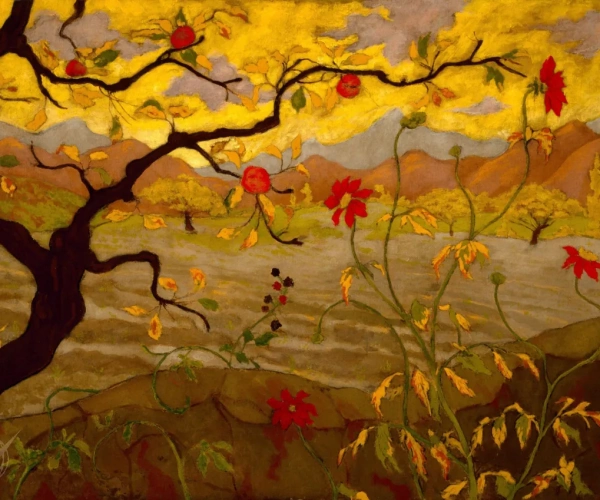Apple Tree With Red Fruit
This painting, created in 1902, is a prominent example of Ranson's Nabis period, characterized by its use of flat colors and decorative patterns. The composition shows a simplified apple tree with vibrant red fruits against a background of lush foliage.
Ranson's use of bold, non-representational colors and rhythmic patterns imbues the scene with a sense of vibrancy and vitality. The simplified forms and flattened space reflect the influence of Japanese woodblock prints, a prevalent source of inspiration for the Nabis group. The deliberate arrangement of colors and shapes creates a harmonious and stylized depiction of nature.
Furthermore, the emphasis on the decorative elements, such as the intricate patterns of the leaves and the rhythmic repetition of the apple forms, demonstrates Ranson's interest in creating a unified visual experience. The overall effect is one of a lyrical and poetic interpretation of the natural world, in line with the Nabis' pursuit of emotional and symbolic content in art.
Ranson's "Apple Tree With Red Fruit" showcases his distinctive style, which is characterized by its departure from naturalistic representation in favor of expressive color and form. This painting exemplifies the Nabis' belief in the intrinsic power of color and line to convey the essence of a subject, rather than focusing on faithful depiction. Through this approach, Ranson achieves a compelling synthesis of nature and artistic interpretation, inviting viewers to appreciate the transcendent beauty of the ordinary.
In conclusion, "Apple Tree With Red Fruit" stands as a testament to Paul-Elie Ranson's innovative vision and the Nabis' commitment to forging a new path in modern art. Through its vibrant colors, rhythmic patterns, and expressive style, the painting captivates the imagination and invites contemplation of the natural world through a lens of aesthetic enchantment.







No Comments Yet...